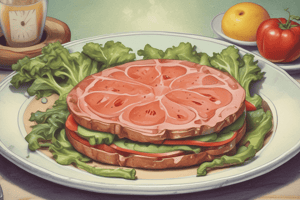Podcast
Questions and Answers
Which condition is necessary for the occurrence of nonpathological forms of ketosis?
Which condition is necessary for the occurrence of nonpathological forms of ketosis?
- Moderate carbohydrate and high fat feeding
- High-protein diet
- Low-fat diet
- High-fat and low-carbohydrate feeding (correct)
How does the ketogenic diet avoid developing into ketoacidosis?
How does the ketogenic diet avoid developing into ketoacidosis?
- By balancing low carbohydrate, moderate protein, and high fat (correct)
- By increasing protein content substantially
- By reducing fat significantly
- By increasing carbohydrate content slightly
What triggers the increase in glucagon secretion in a ketogenic diet?
What triggers the increase in glucagon secretion in a ketogenic diet?
- Hypoglycemia (correct)
- High protein intake
- Hyperglycemia
- High insulin levels
Which of the following is a primary mechanism for weight reduction in a ketogenic diet?
Which of the following is a primary mechanism for weight reduction in a ketogenic diet?
Why is moderate protein intake crucial in a ketogenic diet?
Why is moderate protein intake crucial in a ketogenic diet?
What alternative source of energy does the brain utilize in a ketogenic diet?
What alternative source of energy does the brain utilize in a ketogenic diet?
Flashcards are hidden until you start studying
Study Notes
Nonpathological Forms of Ketosis
- Ketosis occurs when the body is fed a high-fat, low-carbohydrate diet or after severe exercise.
- Excess formation of acetoacetate and 3-hydroxybutyrate, both moderately strong acids, can lead to ketoacidosis, a potentially fatal condition, especially in uncontrolled diabetes mellitus.
Keto Diet (Ketogenic Diet)
- The ketogenic diet is a low-carbohydrate, moderate-protein, high-fat diet that induces ketosis without ketoacidosis.
- This diet can be used for weight reduction without compromising overall health.
Mechanism for Weight Reduction
- A low-carbohydrate diet triggers the body to burn stored fat (lipolysis) for energy.
- Reduced insulin secretion due to hypoglycemia (low blood sugar) reduces lipogenesis (fat storage).
- Increased glucagon secretion due to hypoglycemia stimulates lipolysis (fat breakdown).
Mechanism for Preserving Body Health
- Moderate protein in the ketogenic diet preserves lean body mass, including muscles, without excess protein conversion to glucose.
- Ketone bodies produced in the ketogenic diet serve as an alternative source of brain energy, mitigating the negative effects of low glucose levels on the brain.
Studying That Suits You
Use AI to generate personalized quizzes and flashcards to suit your learning preferences.



